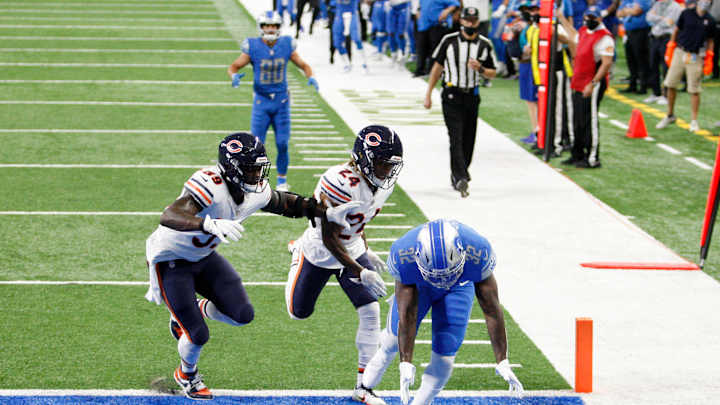If Bears Want to Get Better, Start Here

Every team has weaknesses, even Tampa Bay and Kansas City.
Specific areas of a roster might be weaker than others but the end result of any less talented player grouping is a problem on the field.
As an 8-8 team the last two seasons, the Bears displayed several aspects of play they needed to improve. Some have been addressed to varying degrees in free agency and the draft.
Heading into on-field OTAs this week, the biggest problem areas in the way the Bears play can be corrected. The trouble with some of these problems is they won't know if the issue is solved until they actually start live action in the regular season.
On the positive side, it's a long time until Sept. 12. So, these on-field practices are essential.
5. Run blocking on short-yardage plays
The Bears were not poor blocking line on third-and-one plays at the goal line or elsewhere, but it's an area where they can always improve. In the past they had been less effective.
The offensive line changes they made bringing in bigger, more physical, younger tackles Teven Jenkins and Larry Borom can help push them higher. The Bears converted 75% of their third-and-1 plays, tying them for 12th in the league according to NFLGSIS.com. Not surprisingly, the Super Bowl champion Tampa Bay Buccaneers led the league at this with a 92.9% rate of conversion.
4. Defensive play calling
Defensive coordinator Sean Desai has to be regarded as a liability, until proven otherwise. Desai was a quality control coach who was highly respected but whether he can rapidly adjust on the fly and make the decisions during three hours on a Sunday afternoon is a complete uncertainty.
If you ask most Bears fans what's better, their defensive or offensive play calling, the likely answer would be a resounding win for the defense. Matt Nagy quit calling plays last year in frustration and is going to do it again now.
After three years in this offense, Nagy and the offensive braintrust better know how to call plays. It's Desai's inexperience which should worry everyone. The Bears were in a similar situation in 2007 after Lovie Smith fired Ron Rivera and promoted Bob Babich. Although Babich had been a college coach with experience at this and also a well-respected linebackers coach, he hadn't been an NFL coordinator. Smith had full confidence, though. Babich proved awful at it. The Bears were fifth when they went to the Super Bowl under Rivera, then finished 28th, 21st and 17th with Babich as coordinator before Smith finally took those responsibilities. Babich went to Jacksonville later as coordinator and never had a defense ranked higher than 24th.
The problem is there's no way to know if Desai is another Babich until Sept. 12.
3. Short pass coverage
Covering the left side of the defense deep might become a problem this year, as well, with Kyle Fuller gone. But covering the shorter pass last year was a real Bears problem and it makes sense considering Buster Skrine was their slot cornerback and Danny Trevathan is not the strongest coverage linebacker in the league. He received a 42.3 coverage grade last year from Pro Football Focus, 69th place out out 83 linebackers graded.
According to NFLGSIS.com, the Bears ranked second in the league covering the shorter passes on the left side of the defense, where Roquan Smith and sometimes Khalil Mack normally could be found. They gave up 7.95 yards per pass in the short middle area, 22nd in the league. The 5.25 per pass allowed by the Bears in the short right area might sound good because it was less than what they allowed per pass in the short left, but it ranked 20th in the league. They need to find an answer at slot cornerback and they need to have Trevathan off the field as much as possible in passing situations, with an extra safety playing pass defense.
2. Converting any third-down play
The Bears were the worst team in the NFL at converting third downs. They were at 33.49%, even worse than the Jets and their Dowell Loggains/Adam Gase offense. This is coaching, quarterback play, poor blocking and possibly even the receivers or backs failing to execute, though more often it revolves around the quarterback, play call and blocking. If any team can use the offseason work on-field to smooth out issues in their passing game, it's the Bears.
1. Deep passing
The passing game for the Bears never accounts for enough yards per pass attempt and it's reflected by how poor they are at completing passes downfield, or getting yards after the catch on shorter throws. With Nick Foles and Mitchell Trubisky throwing last year, the Bears were 27th in the league in yards per pass attempt. This wouldn't make them the worst team in the league but that's exactly what they were the previous year. So two years 27th or worse, and they ranked 25th last year at pass plays covering 20 yards or more. They don't get big chunks of yardage in the passing game. So in come Andy Dalton and Justin Fields. It's Fields' strength. Once Dalton did it well but has faded behind some shaky pass-blocking lines. If they're better now, they have to prove it.
Twitter: BearDigest@BearsOnMaven
